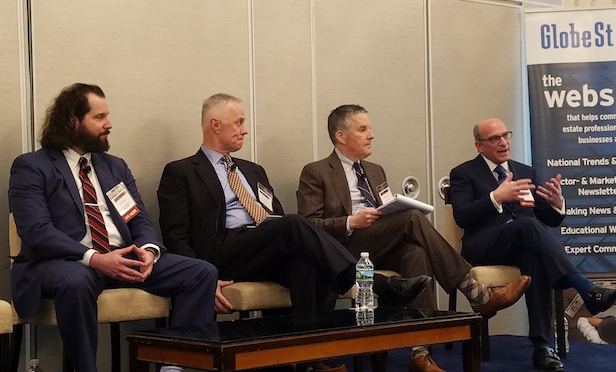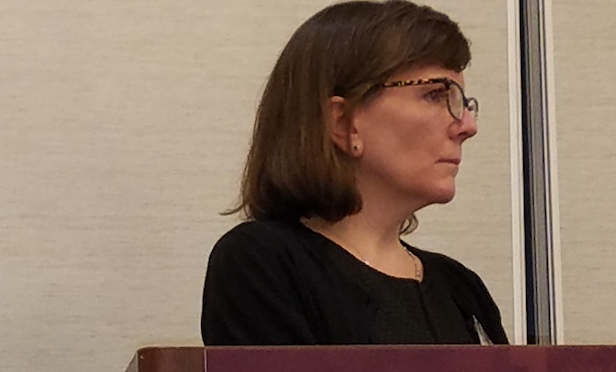
NEW YORK CITY—With tax returns due on Tuesday, April 17, real estate investors are carefully reviewing specific provisions of the new tax law. The RealShare Net Lease Conference in the Park Lane Hotel on April 4-5 in New York City included a session “Breathe Easy: The 1031 Update – Post Tax Reform.”
During the tax reform process, investors were wary that the law would eliminate or whittle down Section 1031 like-kind exchanges to raise revenue to offset other tax reductions. The law ultimately preserved 1031 exchanges for real estate but eliminated them for personal property. Moderator Mary Cunningham, president of Chicago Deferred Exchange Company asked what this meant for investors.
Panelist Marc Wieder, partner and co-practice leader of the real estate industry group at Anchin, Block & Anchin, said prior to the law, with 1031 exchanges when working with a building, FF&E (furniture, fixtures and equipment) were often included in the asset. Property owners sold it all then gave the money to the QI (Qualified Intermediary, an entity that facilitates Section 1031 tax-deferred exchanges).
Now, Wieder sees a wrinkle in that scenario. “The new law does not allow a 1031 with tangible personal property. You will never get the buyer and seller to agree on what amount of the purchase price is allocated to tangible personal property because buyers want a high basis for depreciation purposes. The sellers want a low selling price to minimize the tax on the transaction.”
If the dollar amount assigned to the tangible personal property is book value, the seller does not have to give that amount to the QI and therefore the seller can get cash and pay no tax, as having no gain on the sale of the personal property. However, the IRS could disagree, and conclude on a higher allocation, with the outcome being a taxable situation.
However Wieder added, “To the extent a greater amount of the sale is attributed to your tangible personal property, that amount would be added to the basis of your 1031 and therefore will be depreciable.”
Panelist Mark Baran, co-founder of Four Springs Capital, said his clients use 1031 tax-deferred exchanges looking for safety, preservation of capital, income and opportunity for growth. He pointed to the Delaware Statutory Trust vehicle that is particularly helpful when investing in a single asset investment.
With a 1031, Baran noted, “There is not room for flexibility once the investment is made illiquid until the property is sold down the road at which point the investor has an opportunity to do another 1031 or pay the taxes.”
With the 1031 exchange the investor has 45 days from the date of the sale of the relinquished property to identify potential replacement property. “The 45 days can come quickly,” said Baran. “If an investor comes to the 40th day and finds the preselected property doesn't work out for some reason but did the underwriting, the DST is an opportunity that can be closed on quickly and can be a very nice alternative.”
A Delaware Statutory Trust holds title to investment real estate and qualifies as like-kind exchange property for a 1031 exchange. Typically the minimum investment is $100,000 but it allows investors to diversify exchange proceeds among multiple properties.
Panelist SVP and managing director of real estate analytics at Kay Properties & Investments Jay Salmon noted, “In the past few years, everyone has just been walking on eggshells. I've seen some people choose some not to do 1031,” said Salmon “I've seen people concerned about if they sell, what can they buy?”

Cunningham then asked what are good investments, and is there a bubble in certain sectors?
Panelist Steven P. Katkov, a member of the law firm Cozen O'Connor in the real estate practice, said investment behavior will change with rising interest rates as people have been spoiled for many years with the low ones. However, he has not yet seen his clients slow down at all in their borrowing activity.
The idea of luxury living has exploded in America, including luxury homes, cars and boats, according to Wieder. “The multifamily sector now at a saturation level, is looking or tenants that have gross annual income in excess of $100,000,” he said. “But that market segment is decreasing not increasing in our economy.” However, Wieder added it will be interesting to see where capital goes in the multifamily sector if the concept of “micro-apartments,” small spaces often with luxury amenities, gets legs.
Salmon noted his clients have invested in almost all asset classes over time. He predicts that investors focused on Class A property will enter Class B properties. Plus, with 10,000 baby boomers retiring everyday, he sees assisted living and healthcare as future real estate opportunities.
“You can't go Amazon yourself to the doctor,” he said.
© Touchpoint Markets, All Rights Reserved. Request academic re-use from www.copyright.com. All other uses, submit a request to [email protected]. For more inforrmation visit Asset & Logo Licensing.







